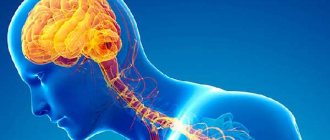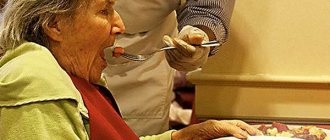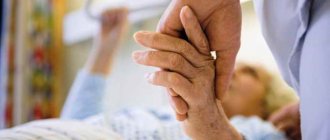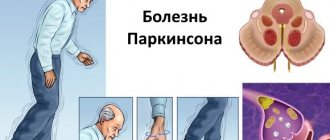Modern scientists know a lot about Parkinson's disease, but doctors cannot yet cope with the pathology or stop degenerative processes in the brain. Chronic neurological disease is characterized by slow, steady progression. Motor disturbances characteristic of the condition lead to a decrease in the physical activity of victims. This causes complications leading to death. Life expectancy with Parkinson's disease depends on a number of factors. If they are taken into account, it is possible to significantly extend the time frame, improve the quality of the patient’s condition, and delay or prevent disability.
Life expectancy with Parkinson's disease depends on a number of factors.
General description of the disease
The disease is dangerous because it leads to disability, severe complications and dramatically reduces the quality of life. Among elderly people, the prevalence of this pathology reaches 1%. People over 45 years of age are at risk. The disease practically does not occur in children.
This pathology was named after the English physician James Parkinson. It was first described in 1817. April 11 is World Day against this disease.
The development of the disease is based on the following pathological changes:
- degenerative processes in the nervous tissue of the brain stem;
- destruction of proteins;
- apoptosis (programmed death) of neurons;
- oxidative stress;
- dysfunction of mitochondria responsible for cellular respiration;
- disruption of the transmission of nerve impulses to muscles;
- disruption of the formation of dopamine, which is a neurotransmitter.
Symptoms of Parkinson's disease: impaired motor function, weakness and drowsiness.
Anatomy of Parkinson's syndrome
The main organ through which human actions are performed is the central nervous system. With its help, signals are sent from the cerebral cortex to one or another movement system. One of the elements involved in this process is the basal ganglia. They are located in the terminal part of the brain at the base of the cerebral hemispheres.
The tasks of the basal ganglia include:
- formation of congenital and acquired motor functions;
- regulation of persistent excitation of muscle tissue;
- control over autonomic and sensory functions;
- regulation of the work of subcortical formations and the cerebral cortex.
From clinical observations it was revealed that the quality and speed of these functions is influenced by the accuracy of the transmitted impulses.
When the basal ganglia are affected, the nerve fiber impulses are disrupted. In addition, this pathological process lowers the level of the neurotransmitter, which regulates the exciting wave from the brain along all neuron processes.
As a result, these deviations lead to hypertonicity and muscle tremors . The medical term for this phenomenon is Parkinson's disease.
Forecast of life expectancy in the last stages of the disease
The disease is incurable. Medications can only relieve symptoms, alleviate the condition of patients and slow down the progression of the disease. Proper nutrition (diet), physiotherapy and brain stimulation help to prolong life in the last stages.
In almost 80% of cases, in the later stages of the disease (if more than 15 years have passed since its onset), the person becomes disabled or dies.
The prognosis largely depends on timely diagnosis and correctly chosen treatment.
Forms of pathology
There are 2 types of parkinsonism:
- Primary. Caused by genetic predisposition.
- Secondary. Occurs against the background of another pathology.
Life expectancy with Parkinson's disease depends on the extent of damage to the substantia nigra.
Depending on the age at which the disease debuts, the following types of Parkinson's disease are distinguished:
- juvenile (at a young age);
- with early debut;
- late (in old and senile age).
Parkinsonism syndrome can be tremulous (tremor comes to the fore in the clinical picture), rigid-tremor (muscle rigidity is combined with resting tremor), tremulous-rigid (tremor predominates over rigidity), akinetic-rigid (paralysis occurs) and mixed.
Ways to extend life
Taking measures to prolong and improve the life of a patient with Parkinson's disease should be taken care of immediately after diagnosis. You should not wait for an increase in the intensity of the clinical picture or the appearance of signs of limitation of the patient’s abilities. The main rule should be strict adherence to the doctor’s recommendations, based on the principles of conservative therapy.
Assistive methods for prolonging life in Parkinson's disease:
- dieting - a ban is imposed only on the consumption of alcohol and foods that lead to atherosclerosis and obesity. The emphasis in the menu is on vegetables, fruits, vegetable fats, dairy products;
- regular physical activity - types of sports and intensity of exercise are selected in accordance with the age and general condition of the patient. Attending dance classes has a good effect;
- development of fine motor skills - needlework, drawing, modeling and other activities that require finger work;
- attending massage sessions, spa treatments - helps relax muscles and improve mood;
- brain training - solving puzzles, reading, learning foreign languages, assembling puzzles stimulate the central nervous system. This allows you to maintain mental clarity longer and delays dementia.
To prolong the life of the patient, a ban is imposed on the consumption of alcohol and foods that lead to atherosclerosis.
These techniques can also be used as passive disease prevention. They have a general strengthening effect on the body, stimulate metabolic processes, and prevent brain pathologies leading to degeneration of nervous tissue.
Clinical picture of stages 4 and 5
Stage 4 of the disease is characterized by a pronounced loss of motor activity while maintaining the person’s ability to stand. He can move independently, but does so with difficulty. At the 5th (last) stage, patients need help from loved ones. They are unable to stand, walk or care for themselves. At this stage they become disabled, bedridden.
Common symptoms of the disease include:
When ill, writing becomes difficult.Involuntary shaking (tremor) in the arms, legs and fingers. Most often it occurs at rest and disappears with movement. The tremor intensifies while holding the pose (when straightening the arms). Postural tremor is less common. Some patients experience intentional trembling in the limbs at the end of the action. Often the lips and tongue are involved in the process. The cause of tremor is muscle hyperstimulation by impulses coming from the central nervous system.
- Difficulty writing.
- Difficulty eating.
- Muscle rigidity (tension, decreased mobility). Manifests itself in the form of strong resistance to passive movements. This pathology is characterized by the cogwheel phenomenon, when the muscles contract unsmoothly and require great effort to move.
- Changes in gait (unsteadiness when walking). Often the gait becomes shuffling. The person moves in small steps.
- Changing the posture (tilting the body forward, slightly bending the knees, bending the elbows and bringing them towards the body). It is observed due to rigidity of the flexor muscles. The pose of a supplicant is typical for illness.
- Loss of postural reflexes.
- Balance imbalance.
- Impoverishment of movements.
- Rare blinking.
- Slowing down movements. The cause is damage to the basal ganglia.
- Frequent falls while moving.
- Poor facial expressions. Manifestation of bradykinesia.
- Heavy, piercing gaze.
- Impaired fine motor skills. Patients are unable to fasten buttons.
- Micrography (changes in handwriting). Manifested by a decrease in the size of letters.
- Illegible handwriting.
- Increased salivation.
- Monotony and muffled speech.
- Reduced speed of thinking.
- Asymmetry of symptoms. Signs of the disease on the left and right can be expressed to varying degrees.
- Impoverishment of emotions.
- Dysarthria (speech impairment).
- Sleep disturbance (daytime sleepiness, nightmares).
- Manifestations of dysfunction of the digestive tract (constipation).
- Dysuria (impaired urination). Both difficulty in excreting urine and pollakiuria (increased micturition) are possible.
- Orthostatic hypotension (a drop in blood pressure when a person assumes an upright position).
- Dizziness.
- Periodic fainting.
- Increased oiliness or dry skin.
- Mental disorders. Patients avoid people, lose interest in life, become pessimistic and irritable. Possible agitation (motor restlessness with strong excitement).
- Visual hallucinations.
- Memory impairment.
- Dementia (dementia).
- Muscle spasms. Occurs predominantly in the legs. Manifested by pain syndrome.
- Pain in muscles and joints.
- Decreased sexual desire and deterioration of erection.
- Attacks of suffocation. They occur due to hypersalivation and saliva entering the respiratory tract.
- Restless legs syndrome. Manifested by involuntary movements, convulsions and paresthesias (tingling, burning, goosebumps) during sleep at night.
Patient care to prolong life
When caring for patients it is necessary:
It is necessary to provide patients with food.Provide them with adequate nutrition. The frequency of meals is 4-5 times a day. The diet should contain fresh fruits, vegetables, dairy products (yogurt, milk, cottage cheese), protein sources (lean meat, fish, seafood, eggs), herbs, cereals, porridges. If necessary, food is given pureed.
- Provide them with psychological assistance. It is important to set the patient in a positive mood, remove suicidal thoughts and help cope with depression. It is necessary for a person to accept the fact of the disease and come to terms with permanent (lifelong) treatment. It is important to ensure a friendly environment in the home, eliminating conflicts and aggression. It is necessary to do everything possible to maintain the patient’s interest in life.
- Do not discuss the patient’s problems in the later stages in his presence.
- Massage your entire body regularly. This helps restore blood flow and relax the body.
- Organize gymnastics. It is better to entrust the selection of exercises to a physical therapy doctor. This can be alternately raising the legs and arms, spreading them to the sides, lifting the pelvis, swinging the arms, and stretching.
- Ensure that medications are taken on time. The patient must drink them in front of his loved ones.
- Wash your body (take a bath) at least once a week.
- Trim the patient's nails and hair.
- Ventilate the room (the patient should not be in a draft).
- Perform simple hygiene procedures (brush teeth if the patient is not able to do this himself, wipe the skin, change bed and underwear).
- Organize exercises for speech development (hire a speech therapist or do it yourself).
- Ensure the safety of the patient. To do this, you need to put locks on windows and medicine boxes, close all sockets, and limit a person’s access to sharp objects (knives, forks) and electrical appliances.
- Provide night lighting (if the patient is able to walk to the restroom on his own).
- Reduce the risk of injuries and falls (equip walls with handrails, make the floor less slippery).
Is the disease curable?
Parkinson's disease is incurable. But you can live with it for many years. To achieve this, scientists create new drugs every year, and doctors develop treatment protocols and ways to suppress symptoms.
What can be influenced in the pathogenesis of Parkinson's?
- From a young age you should monitor your health. Especially if close relatives have parkinsonism. See a doctor promptly. Avoid head injuries. At the first signs of a disorder, undergo a full examination;
- For severe tremor in youth and adulthood, doctors may recommend surgical treatment. It relieves symptoms and allows you to reduce the dose of medications. Unfortunately, like any operation, Parkinson's surgery has a number of contraindications;
- Taking medications daily and changing the treatment regimen in a timely manner allows you to control the clinical manifestations of the disease for many years and normalize the patient’s usual lifestyle. Until the second stage, people with Parkinson's are able to work and can engage in mental work. And after taking the medicine, they allow them to take care of themselves in everyday life and not require outside help;
- Strengthening the muscle corset and daily physical exercise can delay the degeneration of motor activity and changes in posture. Dancing, singing, yoga, and qigong gymnastics have a positive effect on symptoms.
Latest developments in therapy
What exactly have doctors invented over the past 10-20 years to improve the quality of life of patients with Parkinson's disease? Let's talk about this in more detail.
Surgical relief of symptoms
The method of stereotactic thalamotomy was first used back in 1987. During this time, the technique was improved and became more accessible. Its positive and negative sides emerged. Doctors developed indications for the operation. Later, scientists came to the conclusion that thalamotomy is a rather traumatic procedure. It was proposed to replace it with deep brain stimulation.
At the same time, the doctor did not cause any damage to the tissues. Only electrodes were installed in the areas responsible for tremor. Now modern medicine uses these two technologies. The main indication for treatment: severe tremor, poor tolerability and response to conservative therapy, no contraindications to surgical treatment.
Transdermal systems for drug administration
New drugs for Parkinson's disease are patches. They are glued to the skin once a day. A representative of such drugs is the substance rotigotine, a dopamine receptor agonist. Transdermal systems allow relatives to better control the treatment of elderly patients and avoid side effects from constant oral administration of the drug (diseases of the gastrointestinal tract).
Rehabilitation of movement disorders and postural instability on a stabilization platform
Such classes allow you to measure possible disorders, create an individual program for each patient, and improve motor skills. Stabiloplatforms are available in large anti-Parkinsonian centers, specialized sanatoriums, and research institutes. The method is non-drug and highly effective.
Therapeutic measures
Treatment of the disease begins after the diagnosis has been clarified. You will need a survey, a full neurological examination, electroencephalography, electromyography, computed tomography and magnetic resonance imaging, and a physical examination. Because The disease is incurable; therapy can be conservative or surgical. The first involves the use of medications.
The following medications are prescribed:
- Combined antiparkinsonian drugs (Levodopa Benserazid-Teva, Carbidopa/Levodopa, Tidomet Forte, Nacom, Madopar, Benziel). They contain a precursor to dopamine, which is produced in insufficient quantities during illness. The composition also contains an L-amino acid decarboxylase inhibitor, which reduces the formation of dopamine in tissues. Levodopa/Benserazide and its analogues are contraindicated in children and pregnant women, as well as persons with glaucoma, severe cardiac, renal and hepatic pathologies, endocrine disorders, and psychosis.
- MAO inhibitors (monoamine oxidase). This group includes Yumex, which contains selegiline hydrochloride. Release form: tablets. The drug is contraindicated in case of intolerance, Huntington's chorea, essential tremor, as well as in children, pregnant and lactating women. The drug should not be prescribed simultaneously with sympathomimetics, tricyclic antidepressants and serotonin reuptake inhibitors.
- Combined drugs based on dopamine, a decarboxylase inhibitor and a COMT inhibitor (catechol-O-methyltransferase). This group includes Stalevo. The medicine is not prescribed for pheochromocytoma, glaucoma, acute rhabdomyolysis, neuroleptic syndrome, liver dysfunction, children and pregnant women.
- Dopamine receptor stimulants (Bromocriptine, Abergin). In high doses they have an antiparkinsonian effect. Contraindicated in hypertension, coronary heart disease, cerebrovascular pathology, Raynaud's syndrome, obliterating endarteritis, active smoking, peptic ulcer disease, intolerance, heart failure, gestosis, gastrointestinal bleeding.
- Drugs that facilitate the release of dopamine from tissues (PC-Merz, Amantadine). Used intravenously and orally. Contraindicated in renal, liver and heart failure, angle-closure glaucoma, prostate hyperplasia, epilepsy, thyrotoxicosis, low blood pressure, agitation, delirium and in the 1st trimester of pregnancy.
- Inhibitors of cholinergic transmission (Akineton, Bezac, Mendylex). Reduce tremors and muscle rigidity by suppressing the activity of neurons in the striatum. Not prescribed for megacolon, glaucoma, intestinal obstruction and stenosis of the digestive organs.
- Symptomatic drugs (muscle relaxants, antipsychotics, antidepressants). Antihistamines are used according to indications.
Levodopa Benserazide-Teva is a combination drug for Parkinson's disease.
When prescribing medications, the condition and age of the patients are taken into account.
Ambulance for emergencies
In case of emergency conditions (heart attack, acute heart failure, stroke, sepsis), you should call an ambulance. Before her arrival, it is necessary to monitor vital signs (pressure, pulse, pupil reaction, breathing rate). If necessary, resuscitation measures are carried out.
In the absence of breathing and heartbeat, indirect cardiac massage is indicated. It is combined with mouth-to-mouth or mouth-to-nose artificial respiration.
According to indications, nitrates, antihypertensive drugs, thrombolytics, antiplatelet agents and anticoagulants (for thrombosis), antishock drugs (Prednisolone, Atropine, Epinephrine) can be used. Additional measures include ensuring air flow, removing tight clothing, and giving the patient the desired position (on his side or on his back with the head of the bed elevated). If necessary, invasive interventions may be necessary (thrombolysis, catheterization, shunting, intubation, drainage).
Emergency care is provided in case of exacerbation of the disease.
Disability due to pathology
The disability group is given based on the results of a medical and social examination. The general condition, stage of the disease, ability to self-care, degree of loss of motor functions, mental state, condition of vital organs, ability to work and communicate, and concomitant diseases are determined.
Group 1 includes patients who cannot live, work and move without assistance and are constantly on bed rest.
The 2nd group is given to those who have partially preserved the ability to self-care, have 2-sided symptoms, have postural instability and reduced performance.
In the 3rd (mild) disability group, a person is able to care for himself, there is no postural instability or it is mild, there are impairments on both sides and work activity is limited.
Causes of death
Death in Parkinson's disease is most often due to complications resulting from lack of proper care and limited motor activity.
The main causes of death in Parkinson's disease include:
- damage to the respiratory system (bronchopneumonia);
- acute cerebrovascular accident (cerebral infarction or stroke);
- malignant neoplasms;
- the presence of foci of chronic infection;
- suicide attempts resulting from prolonged depression, hallucinations, psychotic states and delusions.
High-quality patient care from medical personnel and relatives allows not only to delay the occurrence of complications, but also to prevent the early development of severe neurological symptoms.
Stages of development of Parkinson's disease
According to the Hen-Yaru classification, the following stages of the disease are distinguished:
- 0 - no motor impairment;
- 1 - symptoms are one-sided;
- 2 - bilateral disorders without postural disorders;
- 3 - postural disturbances are not severe, the person takes care of himself;
- 4 - severe movement disorders, the person moves and stands without the help of others;
- 5 - a person is bedridden, unable to stand or move independently.
Stages of Parkinson's disease (according to Hoehn and Yahr).
At what speed does it progress?
The disease progresses slowly.
The average lifespan of patients without treatment is about 5-10 years.
Slowing progress
Timely diagnosis and medication can help slow the progression of the disease.
General characteristics of the disease
Parkinson's disease is a long-term degenerative disease that affects the central nervous system and primarily affects the motor system. The disease occurs due to a lack of dopamine in the substantia nigra of the brain. The disease mainly affects people whose age is 60 years or more. However, some forms of parkinsonism may occur earlier. It depends on the factor that caused the disease
The clinical picture of the disease usually develops gradually.
Helpful information
In the initial stages of Parkinson's disease, symptoms such as tremors, slow thinking, rigidity of the main muscle groups of the limbs, and problems with independent movement in space are observed.
Also, later behavioral disorders arise, dementia develops, depression and increased irritability are often observed. The main symptoms of the disease include:
- tremor of the limbs;
- increased salivation;
- motor impairment;
- muscle weakness;
- intellectual impairment;
- depression;
- dissomnia disorders (sleep disorders);
- apathy, irritability;
- constipation;
- smell dysfunction;
- disorders of the genitourinary system;
- hypokinesia.
Causes of pathology
The exact causes of the disease have not been established.
Predisposing factors are:
The cause of the pathology can be smoking.burdened heredity;
- elderly age;
- negative impact of environmental factors (toxins, poisons, pesticides);
- uncontrolled use of medications (neuroleptics, antidepressants);
- traumatic brain injuries;
- encephalitis;
- stress;
- insufficient sleep;
- smoking;
- coffee abuse (coffee lovers are diagnosed with pathology more often);
- poor nutrition;
- somatic and endocrine diseases.
Signs in different groups of patients
The clinical picture may differ slightly between young and elderly people. This is due to age-related changes in the brain, the presence of a large number of chronic pathologies and a general weakening of the body over the years.
Young people
In young people, the first symptoms are mild.
A typical sign is different muscle tone in the limbs. It may take 10 years or more for severe movement disorders to appear.
Men and women
There is no difference in the course of the disease in men and women, but men get sick more often.
Therapy methods
The development of Parkinson's disease and life expectancy depend on strict adherence to all the nuances of therapy. The course of treatment is prescribed individually, for each patient separately.
Therapy is carried out in a comprehensive manner, including the following measures: drug treatment, neurosurgery, diet, sports, psychotherapy.
If conservative treatment does not bring the desired result over a long period of time, cryotherapy is prescribed for positive dynamics. A physiotherapeutic procedure using hypothermic action will help eliminate the symptoms of the pathology and prolong the patient’s life. In more severe forms of the disease, neurologists resort to surgical intervention in the brain area.
As you can see, Parkinson's syndrome is a rather dangerous pathology that affects the quality and length of life. There is no need to talk about the elimination of all symptoms and the person’s complete recovery. However, having diagnosed the disease in time, you can begin timely treatment. This approach to your health guarantees a slowdown in the progression of the disease and an increase in life expectancy.
About the treatment of Parkinson's disease and surgical methods
Treatment of the disease in the early and late stages has its own characteristics. At the initial stage, agents are used that increase the synthesis of dopamine, suppress the process of its breakdown, enhance reuptake and stimulate dopamine receptors. They are used as monotherapy or in combination. These drugs are not as effective as Levodopa.
The latter is recommended to be prescribed to older people (after 60 years) or, in low dosage, to younger patients. In later stages, the effectiveness of Levodopa decreases, which requires the use of combination drugs.
Along with traditional treatment methods (medicines, massage, exercise therapy, physiotherapy), the following may additionally be required:
- electrical stimulation of individual brain structures;
- the use of traditional medicine (oat infusion, linden infusion, propolis, St. John's wort infusion, sage infusion);
- surgical interventions (destruction of the subthalamic nucleus, thalamic nucleus).
Destructive operations can be dangerous, so they are carried out according to strict indications.







![Eating Well for Parkinson's Disease [2020 Guide]](https://3d-panneco.ru/wp-content/uploads/pravilnoe-pitanie-pri-bolezni-parkinsona-rukovodstvo-2020-330x140.jpg)


